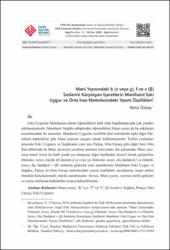| dc.contributor.author | Özbay, Betül | |
| dc.date.accessioned | 2020-12-30T11:07:22Z | |
| dc.date.available | 2020-12-30T11:07:22Z | |
| dc.date.issued | 2020 | en_US |
| dc.identifier.citation | ÖZBAY, Betül. "Mani Yazısındaki ḫ (x veya χ), f ve v (β) Seslerini Karşılayan İşaretlerin Manihaist Eski Uygur ve Orta İran Metinlerindeki Yazım Özellikleri." FSM İlmi Araştırmalar İnsan ve Toplum Bilimleri Dergisi, 16 (2020): 309-319. | en_US |
| dc.identifier.uri | https://dergipark.org.tr/tr/pub/fsmia/issue/58868/849177 | |
| dc.identifier.uri | https://hdl.handle.net/11352/3251 | |
| dc.description.abstract | Eski Uygurlar Manihaizm dinini öğrendikleri halk olan Soğdlardan pek çok yönden etkilenmişlerdir. Manihaist Soğdlu rahiplerden öğrendikleri Mani yazısı da bu etkileşim unsurlarından bir tanesidir. Manihaist Uygurlar özellikle dinî metinlerde tıpkı diğer Manihaist topluluklar gibi Mani yazısını yaygın olarak kullanmışlardır. Turfan yazmaları arasında Eski Uygurca ve Soğdcanın yanı sıra Partça, Orta Farsça gibi diğer bazı Orta İran dillerinde de Mani yazısıyla yazılmış metinler mevcuttur. Bu çalışmada, Mani yazısının temel yirmi üç harfi içinde yer almayan, diğer harflerden ikincil olarak geliştirilen ötümsüz, sızıcı, küçük dil ünsüzü ḫ (x veya χ); ötümsüz, sızıcı, diş dudaksıl f ve ötümlü, sızıcı, diş dudaksıl v (β) seslerini gösteren yazı işaretlerinin Manihaist Eski Uygur ve Soğdca, Partça ile Orta Farsça metinlerdeki yazım özellikleri incelenmiş; tespit edilen örnekler karşılaştırmalı olarak sunulmuştur. Ayrıca, Mani yazısı, yazının tarihî gelişimi ve yazıyı kullanan halklardan kısaca bahsedilmiştir. | en_US |
| dc.description.abstract | Old Uygurs had a significant influence on many aspects of Sogdian people, and they also learned Manichaeism from them. One of the important interaction elements between these people is the Manichean script, which was taught by Manichean Sogdian monks to Old Uyghurs. Manichean Uyghurs used Manichean script for their religious texts, just like the other Manichean communities. In Addition to Old Uyghur and Sogdian, there are many texts in the Manichean script which were written in Parthian, Middle Persian, and some other Middle Iranian Languages in Turfan region. In this study, the writing features of the letters for the consonants voiceless, fricative, uvular ḫ (x or χ); voiceless, fricative, labiodental “f” and voiced, fricative, labiodental “v” (β), which were developed secondary to other letters, were examined; moreover, the determined samples were presented comparatively. While we were giving this, we also briefly mentioned the Manichean script, and the historical development of the writing, and the people who used it. | en_US |
| dc.language.iso | tur | en_US |
| dc.publisher | FSM Vakıf Üniversitesi | en_US |
| dc.rights | info:eu-repo/semantics/openAccess | en_US |
| dc.subject | Mani Yazısı | en_US |
| dc.subject | “ḫ” (x), “f” ve “v” (β) harfleri | en_US |
| dc.subject | Soğdca | en_US |
| dc.subject | Partça | en_US |
| dc.subject | Orta Farsça | en_US |
| dc.subject | Eski Uygurca | en_US |
| dc.subject | Manichean Script | en_US |
| dc.subject | The letters “ḫ” (x), “f” and “v” (β) | en_US |
| dc.subject | Sogdian | en_US |
| dc.subject | Parthian | en_US |
| dc.subject | Middle Persian | en_US |
| dc.subject | Old Uyghur | en_US |
| dc.title | Mani Yazısındaki ḫ (x veya χ), f ve v (β) Seslerini Karşılayan İşaretlerin Manihaist Eski Uygur ve Orta İran Metinlerindeki Yazım Özellikleri | en_US |
| dc.title.alternative | The Writing Features of the Letters “ḫ” (x or χ), “f”, and “v” (β) in the Manichean Script in Middle Iranian and Old Uyghur Manichean Texts | en_US |
| dc.type | article | en_US |
| dc.contributor.department | FSM Vakıf Üniversitesi, FSM İlmî Araştırmalar İnsan ve Toplum Bilimleri Dergisi | en_US |
| dc.relation.publicationcategory | Makale - Ulusal Hakemli Dergi - Kurum Öğretim Elemanı | en_US |



















